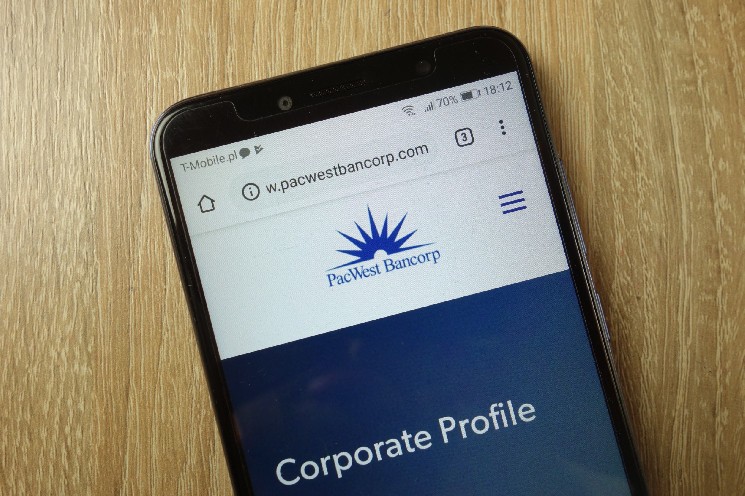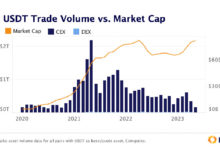PacWest Leads Friday Bank Rally, Closes 81.70% In the Green

After falling sharply throughout the week, the shares of multiple US regional banks experienced a dramatic rally on Friday, May 5th. PacWest saw the most significant rise throughout the day and closed more than 82% in the green. Despite the positive turn today, most of the banks’ shares are still significantly lower than they were when they opened on Monday.
Regional Banks Rally Significantly on Friday But Fail to Recover All of the Week’s Losses
Throughout Friday, the stocks of multiple American regional banks experienced a significant rally. PacWest’s shares saw the most significant rise and closed the trading day 81.70% in the green at $5.76. Despite the rally, the bank is still down more than 43% since Monday as it had, among other setbacks, experienced a sharp drop on Wednesday after it was reported it is seeking a buyer.
Western Alliance also saw a dramatic rise of 49.31% on Friday. The bank was embroiled in drama on Thursday when it declined close to 50% after a Financial Times report indicated it is, much like PacWest, exploring strategic options. On the same day, the bank’s shares whipsawed and mildly recovered after it published a statement claiming the initial report was false.
Despite also dropping around 37% for the week, the shares of First Horizon Bank failed to recover as much as the other two lenders on Friday. Its stock was up only 8.75% by the market’s close as the major reason for its drop came in the form of a failed merger with the Toronto-Dominion Bank.
Why Are US Regional Banks Down This Week?
The key event that triggered the selling pressure experienced by multiple US regional banks this week was the receivership and sale of First Republic early on Monday. The regulatory action reignited the banking crisis that has been relatively dormant for around a month and that started in the first half of March.
Between March 8th and 13th, three US regional banks—Silevrage, Silicon Valley, and Signature—were either liquidated or shut down by the authorities. While the government subsequently implemented emergency measures to stabilize the situation, they failed to fully restore confidence after it was revealed that the lenders were using the discount window to borrow at a pace not seen since 2008.
By mid-March, First Republic emerged as the most likely fourth bank to fall victim to the crisis. While multiple attempts to rescue the lender, including a $30 billion injection by some of America’s largest banks, were made, the company was ultimately seized at the beginning of this week.







 Bitcoin
Bitcoin  Ethereum
Ethereum  Tether
Tether  Dogecoin
Dogecoin  USDC
USDC  Cardano
Cardano  TRON
TRON  Bitcoin Cash
Bitcoin Cash  Chainlink
Chainlink  LEO Token
LEO Token  Litecoin
Litecoin  Cronos
Cronos  Stellar
Stellar  Ethereum Classic
Ethereum Classic  Dai
Dai  Stacks
Stacks  Monero
Monero  Hedera
Hedera  OKB
OKB  Cosmos Hub
Cosmos Hub  Algorand
Algorand  Theta Network
Theta Network  Maker
Maker  KuCoin
KuCoin  Gate
Gate  EOS
EOS  Polygon
Polygon  NEO
NEO  Tezos
Tezos  Tether Gold
Tether Gold  Zcash
Zcash  Bitcoin Gold
Bitcoin Gold  IOTA
IOTA  TrueUSD
TrueUSD  Synthetix Network
Synthetix Network  Holo
Holo  Zilliqa
Zilliqa  Dash
Dash  0x Protocol
0x Protocol  Qtum
Qtum  Siacoin
Siacoin  Ravencoin
Ravencoin  Basic Attention
Basic Attention  Enjin Coin
Enjin Coin  Decred
Decred  Ontology
Ontology  NEM
NEM  Lisk
Lisk  Status
Status  DigiByte
DigiByte  Waves
Waves  Nano
Nano  Pax Dollar
Pax Dollar  Numeraire
Numeraire  Hive
Hive  Steem
Steem  Huobi
Huobi  BUSD
BUSD  Ren
Ren  OMG Network
OMG Network  Bitcoin Diamond
Bitcoin Diamond  Bytom
Bytom  Kyber Network Crystal Legacy
Kyber Network Crystal Legacy